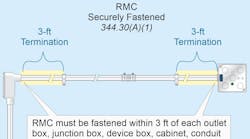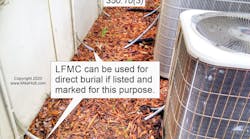Q. What are the acceptable wiring methods for photovoltaic (PV) circuits inside buildings/structures?
A. PV system DC conductors (source and output) run inside a building/structure must be contained in a metal raceway, Type MC cable, or metal enclosure [690.31(E)]. Wiring methods cannot be located within 10 in. of the roof decking or sheathing, except where located directly below the roof surface that's covered by PV modules and associated equipment and must be run perpendicular (90°) to the roof penetration point [690.31(E)(1)]. Note: The 10 in. from the roof decking/sheathing requirement is to prevent accidental contact with energized conductors from saws used by firefighters for roof ventilation during a structure fire.
FMC smaller than trade size ¾ in. or Type MC cable smaller than 1 in. in diameter installed across ceilings or floor joists must be protected by substantial guard strips that are at least as high as the wiring method. Where run exposed, other than within 6 ft of their connection to equipment, wiring methods must closely follow the building surface or be protected from physical damage by an approved means [690.31(E)(2)].
Wiring methods and enclosures containing PV source conductors must be marked with the wording "Photovoltaic Power Source" by labels or other approved permanent marking means [690.31(E)(3)]. The marking required by 690.31(E)(3) must be visible after installation and appear on every section of the wiring system separated by enclosures, walls, partitions, ceiling, or floors. Spacing between labels/marking must not be more than 10 ft, and labels must be suitable for the environment [690.31(E)(4)].



